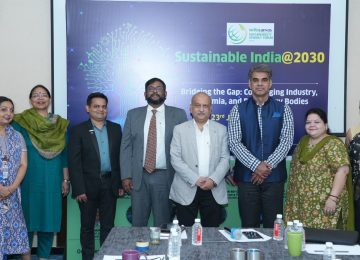Sustainability is a journey for businesses and our society. It is a long-term endeavour for any industry, and there are immense challenges to overcome along the way. It can be demanding, costly, and filled with obstacles in terms of achieving profitability in a short term but has surefire benefits in the longer run. Recent political, social, and industrial developments have highlighted transformational trends like net zero and circular economy. By following these trends, the construction sector can play a crucial role in this journey, through the use of upcoming technology that changes the dynamics within this industry.
Green construction holds the key to the construction of a greener future. Today, the need to build green is dire and urgent. The one common thread almost all humans share is the fact that we live and operate in architectural structures. Since this fact is not likely to change in the near future, we need to start leveraging technology to build sustainably today, for a sustainable tomorrow for us and our future generations.

Making it possible to manage the present, road-map the future and learn from the past to build better. Digital twinning can help decarbonize the construction of new and existing buildings through visualization and analysis of various data, integration with renewable energy networks, and effective operational collaboration and engagement.
Amidst the rising popularity of renewable energy sources, solar energy has come a long way from the conventional notion of massive equipment and space requirements for solar panels. In this technologically advanced era, harnessing solar power doesn’t always require equipment. A new solution, passive solar architecture design uses the sun’s rays to heat a building through strategic placements of windows. Multiple sets of such windows help let in solar energy and heat-absorbing surfaces such as dark walls capture the heat to warm the building. While active solar systems certainly provide more heat than the passive counterparts, using heat to warm air or water cuts down on gas and electricity consumption, leading to reduced costs that make up for the upfront investment.
However, solar energy isn’t the only light at the end of the tunnel. Lighting solutions like LEDs (Light-Emitting Diodes) and OLEDs (Organic Light-Emitting Diodes) also present the possibility of a brighter future (all puns intended). OLEDs even surpass the cost-saving potential of a standard LED, which itself provides illumination for twice as long as fluorescent bulbs and more than twenty times longer than incandescent light fixtures. An OLED takes far fewer chemicals to produce and is extremely versatile in its use due to its pliability. Large sheets of this material can conduct and emit light, making it ideal for screens and display monitors. In the future, OLEDs can be used on a large scale on walls and facades to generate light at a fraction of the energy consumption rate used by other types of illumination.
The concept of digital twinning intersects with the aforementioned illumination innovations to create the process of energy modeling. Energy modeling happens when an integrated suite of applications is used to accurately and at regular time intervals, measure and simulate thermal and electric requirements for buildings of any size and complexity.
Even at a consumer level, one can purchase appliances equipped with smart meters that gather real-time data which can be communicated with other devices. This data can determine energy rates and automatically run when energy rates are at their lowest. Combined with the Internet of Things, advanced data analytics, and the digital economy, these advancements are allowing us to plan more effectively, using integrated ecosystems of smart devices. Thereby allowing us to build in ways that limit the requirement of human intervention, lower costs, and maximize operational efficiency.
However, all this innovation cannot be truly effective without regulation and quantification. In order to close the sustainable design loop and address the performance gap between how buildings are designed and how they perform in operation, the construction industry needs to set performance metrics and analyze against them across the whole process: master planning, design, construction, commissioning, handover, operation, renewable integration, retrofit and end of life.
These burgeoning technologies hold immense potential for greener construction which will not only help us achieve neutrality but also help us achieve net positive emissions and a more sustainable future that we can all inhabit while creating ample room for the sustenance and growth of future generations.
Any sustainable project needs multidisciplinarity, integration, and recognition of different strategies within sustainable categories. Some criteria may be optional & some would be mandatory; let’s see how they all make important contributions to sustainability in construction in our next article. (The article is authored by Sudhir Soundalgekar, Executive Vice President — Sustainability, Amplo Global Inc.)









